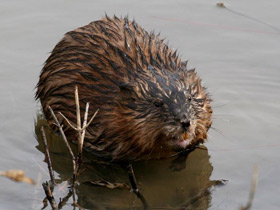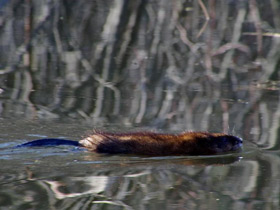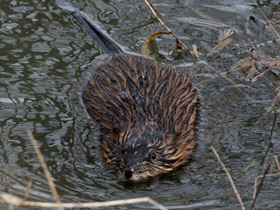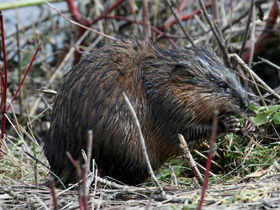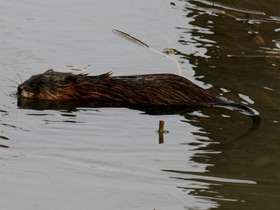The muskrat (Ondatra zibethicus)
The muskrat (Ondatra zibethicus) is the only extant species in the genus Ondatra and tribe Ondatrini. It is the largest species in the subfamily Arvicolinae, which includes 142 other species of rodents, mostly voles and lemmings. Muskrats are referred to as "rats" in a general sense because they are medium-sized rodents with an adaptable lifestyle and an omnivorous diet. They are not, however, members of the genus Rattus. They are not closely related to beavers, with which they share habitat and general appearance.
Appearance and distinctive features
Outwardly, Ondatra zibethicus looks like a rat (it is often called a musk rat), although its size is much larger than that of a muskrat: the weight of adults can reach 1.8 kg, body length - 23-36 cm, tail length is almost equal to the body length - 18-28 cm. Sexual dimorphism in this rodent is not pronounced. The body of Ondatra zibethicus is valvate, the neck is short, and the head is small and blunt-faced. Its whole appearance indicates adaptation to the aquatic way of life. The auricles barely protrude from the fur; the eyes are small and highly set. The lips, as in Ondatra zibethicus, are formed with incisors, isolating them from the oral cavity, thanks to which the muskrat can chew off plants under water without choking. The tail of this aquatic rodent is flattened from the sides, covered with small scales and sparse hairs; a ridge of elongated stiff hairs runs along its underside. The hind legs have swimmers' webbing and a fringe of short hairs around the edges of the toes. The fur of Ondatra zibethicus consists of coarse hairs and soft undercoat. The colouration of the back and limbs is dark brown to black. The belly is lighter, sometimes greyish-blue. The fur of Ondatra zibethicus is very thick, dense and luxuriant, which makes it waterproof. Ondatra zibethicus constantly takes care of its fur: lubricates it with fatty secretions and combs it.
Ondatra zibethicus can stay in water for a long time
Another, but already physiological adaptation to the aquatic lifestyle is the increased content of haemoglobin in the blood and myoglobin in the muscles - this creates additional oxygen reserves when submerged under water. Another special adaptation is heterothermy, the ability to regulate blood flow to the limbs and tail; the limbs of the muskrat are usually colder than the body.
Habitat
Ondatra zibethicus was originally distributed in the near-water habitats of North America, almost everywhere from Alaska and Labrador to Texas and northern Mexico. Several times this rodent was imported to Europe, and it spread widely across Eurasia, as far as Mongolia, China and Korea. In Russia, the muskrat's range goes from the borders of Finland through the entire forest zone of the European part of Russia and a significant part of the forest-steppe and taiga zones of Siberia to the Far East and Kamchatka. Ondatra zibethicus is also found in Israel on the banks of freshwater rivers.
Ondatra zibethicus was first introduced to Europe in 1905, when several pairs of muskrats were released near Prague, where they quickly became accustomed and, in the absence of predators, began to actively breed and disperse. By 1933 Ondatra zibethicus had become quite common in the countries of Western Europe. This rodent was first introduced to Russia in 1928, and by the end of the 40s Ondatra zibethicus became a commercial animal on a par with the squirrel. From Russia, the rodent travelled further - to China, Korea and Mongolia.
Where Ondatra zibethicus live and what they eat
Ondatra zibethicus leads a semi-aquatic lifestyle, settling along the banks of rivers, lakes, canals and especially willingly in freshwater marshes. It prefers shallow (1-2 m deep), not freezing water bodies with banks covered with dense herbaceous vegetation. These rodents are active around the clock, but most often after sunset and early in the morning. They feed on coastal and aquatic plants - reeds, hornwort, rushes, sedges, horsetails, arrowleaf and rdestas. In spring Ondatra zibethicus feeds on young stems and leaves, in summer and autumn it eats root parts and rhizomes, in winter only rhizomes. It also eats agricultural crops. Less often, when plant food is scarce, it eats molluscs, frogs and fish fry.
Ondatra zibethicus builds burrows and huts for dwelling. The length of burrow passages varies, up to 3 m in steep banks and up to 10 m in gentle banks. The burrow opening is located under water and is not visible from the outside, while the nesting chamber is above the water level. Nesting chambers are sometimes arranged in two floors and connected by passages, as this is provided in case of changes in the water level. Even in the harshest frosts the temperature in muskrat nesting chambers did not drop below 0 °C. On low waterlogged banks muskrat builds above-water dwellings - huts up to 1.5 m high - from stems of aquatic plants bound with silt. The entrance to them is also located under water. It also builds floating open nests - feeding grounds. In addition to dwelling houses Ondatra zibethicus make and storerooms where they store food for the winter. Slow on land, Ondatra zibethicus swims well and dives well. It can go without air for up to 12-17 minutes. Its eyesight and sense of smell are poorly developed and it relies mainly on hearing.
Social behaviour
Ondatra zibethicus live in family groups with their own feeding grounds. The inguinal glands of males secrete a musky secretion with which they mark their territory. They are intolerant to aliens, and only during wintering they form aggregations. In spring females drive their young from the territory; cannibalism is known in cases of overpopulation. In spring and autumn, Ondatra zibethicus, which have no families or feeding grounds of their own, make long-distance migrations in search of free water bodies.
Reproduction
Pregnancy of the female lasts 25-30 days; the litter averages 7-8 cubs. In northern areas there are 2 broods per year and reproduction is limited to the warm months from March to August; in southern areas reproduction is almost uninterrupted, and the female may raise 4-5 broods per year. The male brings food to the nursing female for the first weeks after birth, thus creating conditions for high survival of cubs. Cubs at birth are blind and weigh about 22 g. On the 10th day they can swim, and on the 21st day they begin to eat plant food. By the 30th day young Ondatra zibethicus become independent, but they stay with their parents for the winter and disperse only in spring. Ondatra zibethicus reach sexual maturity at the age of 7-12 months. The maximum lifespan of Ondatra zibethicus in the wild is up to 3 years, in captivity - up to 10 years.
Subspecies
Ondatra zibethicus has 16 subspecies:
- Ondatra zibethicus albus,
- Ondatra zibethicus aquihnis,
- Ondatra zibethicus bemardi,
- Ondatra zibethicus cinnamominus,
- Ondatra zibethicus macrodom,
- Ondatra zibethicus mergens,
- Ondatra zibethicus obscurus,
- Ondatra zibethicus occipitalis,
- Ondatra zibethicus osoyoosensis,
- Ondatra zibethicus pallidus,
- Ondatra zibethicus ripensis,
- Ondatra zibethicus rivalicus,
- Ondatra zibethicus roidmani,
- Ondatra zibethicus spatulatus,
- Ondatra zibethicus zalaphus
- Ondatra zibethicus zibethicus.
Invasiveness status
In Europe, the muskrat has been included in the list of invasive alien species of Union concern (the Union list) since August 2, 2017. This implies that this species cannot be imported, bred, transported, commercialized, or intentionally released into the environment in the whole of the European Union.
In human history
Native Americans have long considered the muskrat to be an important animal. Some predict winter snowfall levels by observing the size and timing of muskrat lodge construction.
In several Native American creation myths, the muskrat dives to the bottom of the primordial sea to bring up the mud from which the earth is created, after other animals have failed in the task.
Muskrats have sometimes been a food resource for North Americans. In the southeastern portion of Michigan, a longstanding dispensation allows Catholics to consume muskrat as their Friday penance, on Ash Wednesday, and on Lenten Fridays (when the eating of flesh, except for fish, is prohibited); this tradition dates back to at least the early 19th century. In 2019, it was reported that a series of muskrat dinners were held during Lent in the areas along the Detroit River, with up to 900 muskrats being consumed at a single dinner. The preparation involved the removal of the musk glands and the gutting and cleaning of the carcass, before the meat was parboiled for four hours with onion and garlic and finally fried.
Muskrat fur is warm, becoming prime at the beginning of December in northern North America. In the early 20th century, the trapping of the animal for its fur became an important industry there. During that era, the fur was specially trimmed and dyed to be sold widely in the US as "Hudson seal" fur. Muskrats were introduced at that time to Europe as a fur resource, and spread throughout northern Europe and Asia.
In some European countries, such as Belgium, France, and the Netherlands, the muskrat is considered an invasive pest, as its burrowing damages the dikes and levees on which these low-lying countries depend for protection from flooding. In those countries, it is trapped, poisoned, and hunted to attempt to keep the population down. Muskrats also eat corn and other farm and garden crops growing near water bodies.
Royal Canadian Mounted Police winter hats are made from muskrat fur.









